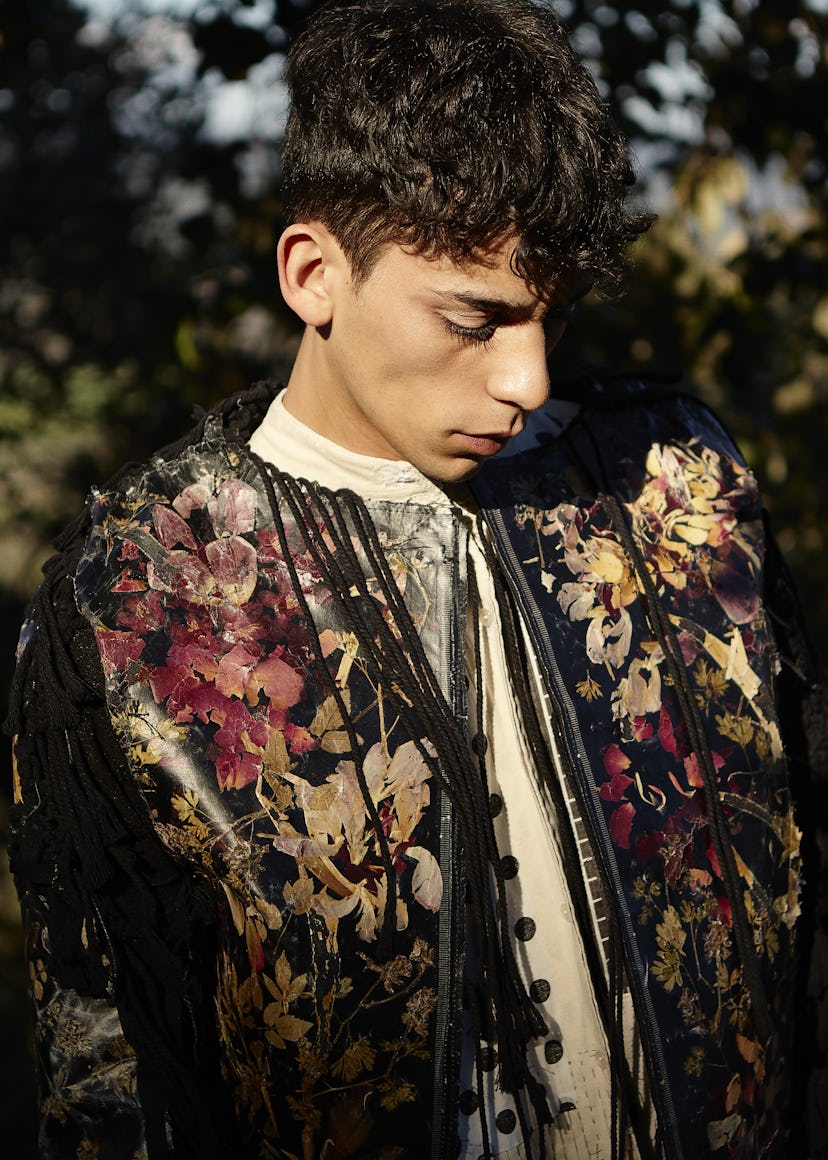A Finnish Design Duo Taking Hyères by Storm
Hanne Jurmu and Anton Vartiainen were inspired by Karl Lagerfeld’s Egyptian-inspired designs from the ’70s–and it paid off.

While Japan’s Wataru Tominaga took home the grand prize at this year’s Hyerès International Fashion and Photography Festival, Finnish duo Hanne Jurmu, 26, and Anton Vartiainen, 23, stole the hearts of the jury with their brightly colored men’s wear–and won the Chloé Prize, which includes a €15,000 grant and the chance to collaborate with the brand. Here, the designers discuss their collaboration, artistic process, and what’s next.
Your clothes are patched and tattered like a marvelous, unravelling tapestry. Where does the material come from? We found material all over the place. Some of it is from our old clothing, some are cast off toiles from school, some we found from the recycling center or in dumpsters. One reason we did this was that we didn’t have the money to buy fabric, but it’s also because we didn’t feel like buying fabric. It seems crazy to order new material from another continent for something as basic as clothing. In Finland there’s hardly any fabric production today, and indigenous people have always been able to produce their clothing from nearby sources. We started with this in mind and soon realized that the material needs to be more vivid to pass the fashion test. One way to look at it would be to say that we enslaved ourselves to the clothing. It took hours to “produce” the material. And it was ready when it told us. We were investigating the idea of boro (the clothes monks have worn for centuries which they always mend whenever holes appear. These clothes have character. It takes a strong person to wear them.
You covered your collection with pressed flowers. How did you come up with that idea? We discovered pressed flowers when we were drawing. The colors of real flowers are so vivid and true. When we found a stock of pressed flowers discarded in the backyard of a shop, we asked ourselves: why not take a more direct apporach and use them ?
What other techniques did you invent and use? We avoided the idea of decorating because it’s superficial. We used macramé knotting to bind things together and for shoes. And we were inbspired by potter friends to make molds for Latex trousers that we bound together with macramé. The idea behind this was to achieve zero waste by using liquid materials and yarn. We even managed to dry melon skins on milliner’s blocks for hats.
The male models that you cast were talking to themselves on the runway. Who were they? And why did you choose to have them speak? We find models more interesting backstage than when they’re walking like zombies, wearing a model face in a typical fashion show. We asked ours to talk during the show as a way to free them from the role of being a model. We wanted them to affect the show. Since life is unpredictable, why not let something unexpected happen? The whole idea for this collection is that conscious ideas arise from the unconscious. Two models, Antti and Oscar, were cast from Finland. They’re good friends and we’ve always thought of them as beautiful inside and out with strong characters. They’re what one could call old souls.
How do you intend to pursue fashion design as a career? AL : We’ve been talking about working in an self-sustainable and small-scale manner. We hope in ten years that fashion will be about people’s needs, about connecting, about love. HJ: My plan is to graduate with my MAs at the end of the year. I will work on my thesis in the summer. There are some interesting projects coming, for example we are proud to be one of the designers of the Pre Helsinki fashion platform and we will have presentations in an old villa here in Helsinki at the end of May. Our future is not planned at all, generally speaking I want to keep learning, developing and bringing these ideas forward in my work. The most important thing for me is to be true to myself and the world.
What does winning the Hyères Festival Jury special mention and the Chloé Prize mean to you? This gives us a lot of self-confidence and assurance that our thoughts and visions can be shared in fashion. The Chloé Prize means we get the chance to work with Chloé. We’re excited to see what that collaboration will be like.
What did you design for Chloé ? We designed a wedding dress since it’s something that love, effort and time has been put into. To do that we looked into Karl Lagerfeld’s Spring/Summer 1974 collection for Chloé, when he sent a team to Egypt to research the interior design of tombs. We wanted our dress to reflect the idea that the woman who wears it is part of her surroundings. There was also the question : why is something as beautiful as a bride’s dress worn just once ? So we designed a two-piece dress with a pressed flower bodice and a silk velvet underskirt over a wrapable white dress of cotton organza with smocked bodice and silk chiffon hem. The wedding dress symbolizes the moment when a girl becomes a woman and the Chloé girl’s “attitude” is very much about that: keeping both a girl’s and a woman’s aspects.
Photos: A Finnish Design Duo Taking Hyères by Storm
Photo by Adrien Toubiana, Thomas Cristiani. Styled by Danielle van Camp. Produced by Kitten.
Photo by Adrien Toubiana, Thomas Cristiani. Styled by Danielle van Camp. Produced by Kitten.
Photo by Etienne Tordoir.
Photo by Etienne Tordoir.
Photo by Etienne Tordoir.
Photo by Etienne Tordoir.
Photo by Etienne Tordoir.
Photo by Etienne Tordoir.
Photo by Etienne Tordoir.
Photo by Etienne Tordoir.